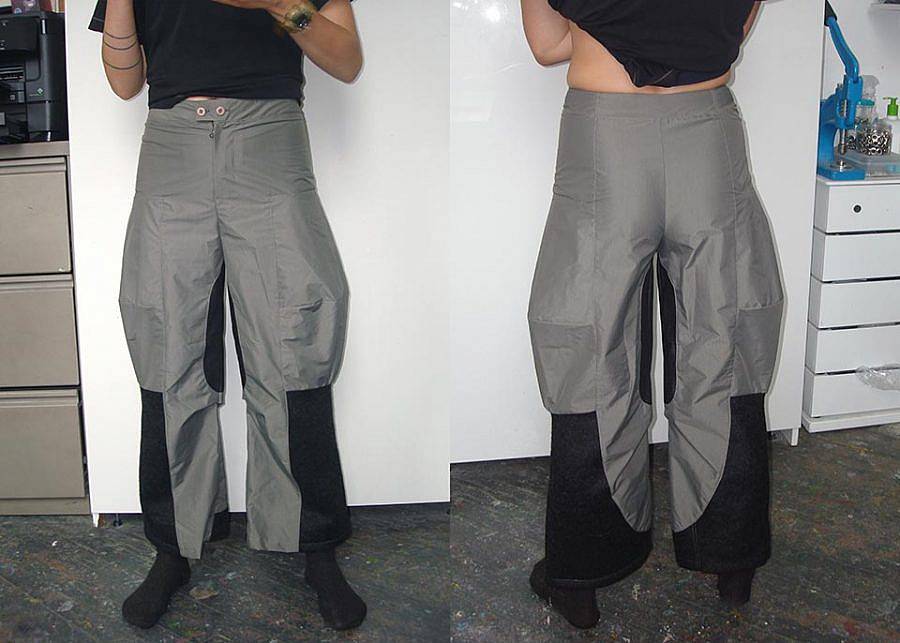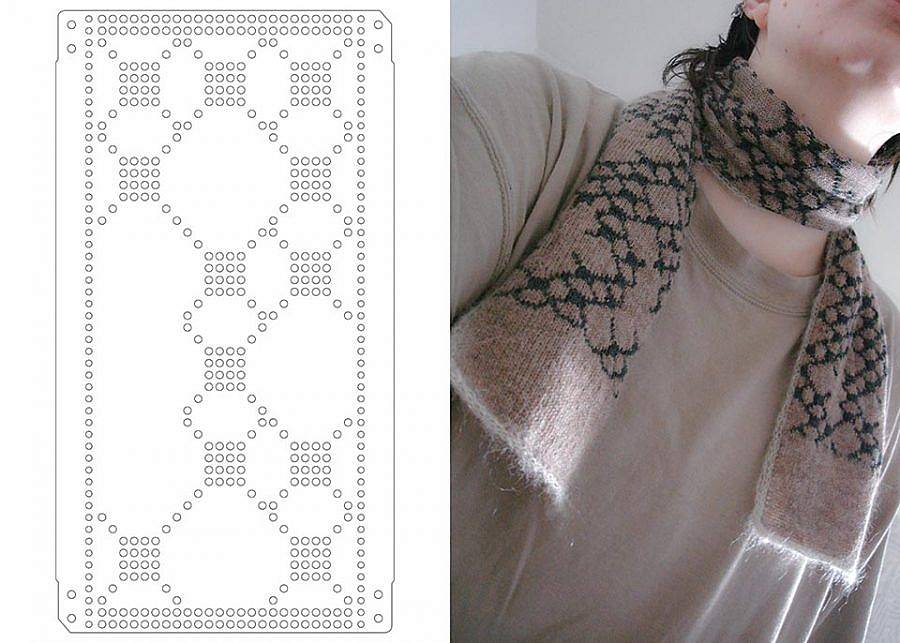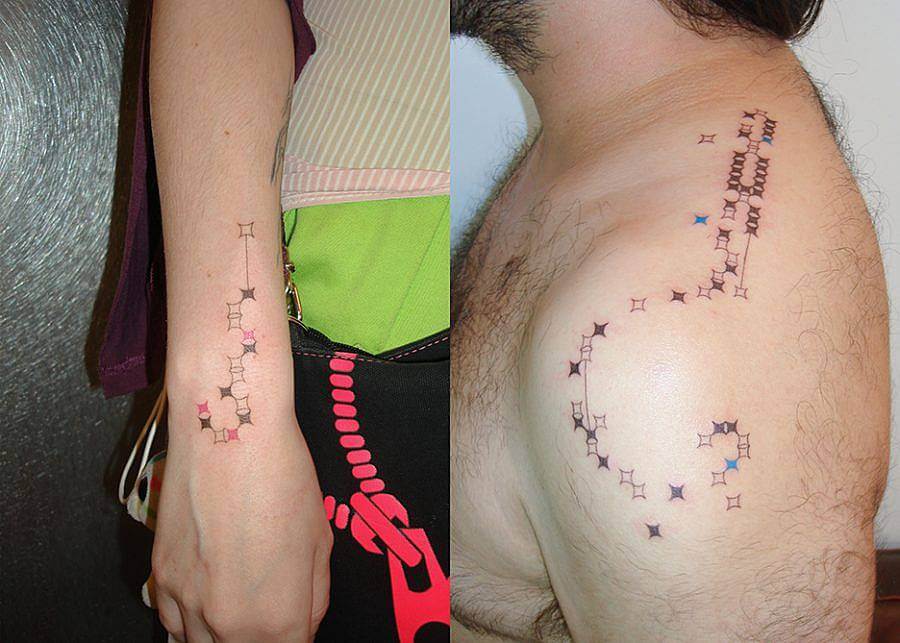Tell us a little about yourself and what you do.
I grew up in California and Texas, over the last decade I’ve spent my time in Portland, Chicago, and now New York. I run a garment project called KNIT BODY and I give hand-poke tattoos under the moniker Soft Coder. Most everything I do revolves around knitting in some capacity, or more broadly the relationship between craft and technology. I work out of a collaborative sewing / tattoo studio in Brooklyn, NY.
How did you become interested in and begin tattooing?
When in Portland in my early 20s, I lived with a few hand-poke tattooers and was around it a lot during those years. I mostly learned how to tattoo through them and through tattooing myself. Back then, I would tattoo friends in my living room for fun because I loved how tactile the process was, but it never crossed my mind to take it any further than that. Then while in Chicago, I had just graduated from school a month after the pandemic hit and was still steeped in my thesis project in which I was translating knitting patterns into these large data drawings, or “codes”. I was enamored by this project and over time started adopting the format of these translations as a sort of intuitive drawing practice i.e. taking some process-driven patterns and working them into compositions. I was thinking of these as a sort of faux language or illegible sheet music. I had notebooks full of these code drawings, and eventually tattooed one on myself. I lived with another tattooer at the time and we had space in the apartment for it, so I started tattooing a few on friends and then it kind of took off. It was strange starting to tattoo mid-pandemic but I’ve been doing it as my job since, so for about 3 years now.

What have you been listening to lately?
I’m all over the place with music. When I’m tattooing, I just shuffle my liked songs and let it play so it’ll be an eclectic mix of jazz, pop, disco, a lot of ambient and experimental electronic, etc. I like a lot of different music and I like the chaos of the shuffle, but I’ve been building out a more smooth-playing tattoo playlist for the summer so I’ll share that here. *Shuffling recommended*
Most of the knit body garments have a futuristic and technological appearance, is this something that you think about when designing?
I’ve always been attracted to both synthetic and soft natural materials. When I learned how to knit, I was fixated with how slow and bodily the process is, using modular movement to build material which goes on to cloak the body again; a body-to-body technology that’s been around for centuries. Then on the flip side, there’s a rising industry of protective technical fabrics and in turn technical design which has recently become more popular in fashion. The gorpcore aesthetic, you know. And there’s a lot happening here regarding ergonomic and highly utilitarian design, and especially its ability to shield the body from increasingly volatile weather patterns. Of course, there’s only so much a waterproof garment can do, but now everyone wants to be prepared to face the elements. I think that sensibility is here to stay, and I’m interested in it.
When I think of getting dressed in the future, I imagine clothing will be a lot about fantasy and absurdity and utility. I imagine we are shielded from the world via synthetics but the layers that are closest to the body are quilted cottons and knitted wools. The things I make reflect that vision while preserving the legibility of labor and handwork that has long made the production of fine garments so special. You know what I mean, if you’ve ever worn a hand-knit sweater, or a hand-stitched garment. It’s evident the work that goes into these pieces, the variation in tension and the presence of human mistake. I don’t like thinking about a future where the hand isn’t present, even if the rest of our world is increasingly synthetic.
I always found it so interesting how the history of textiles and the history of technology are so heavily intertwined. For example, the mechanization of the cotton industry being the driving force behind the industrial revolution and the Jacquard loom punch card system being the predecessor for early binary computing. While these systems are so tied, they also seem antithetical in ways—the hand and the machine—and so there’s tension here too. Like, who gets to play the role of producer and what is the result of that? Anyway, I enjoy this tension a lot. I think highly of this relationship, and that’s probably reflected in my material choices and how I choose to make the things I do.

Can you talk about the way that the code imagery reoccurs throughout both your tattoos?
The code imagery comes from my other thesis project I was working on at SAIC. I was really into this website Ravelry.com, which is a digital craft community often used by knitters. I became fascinated with how knitters use shorthand to write out their patterns, like a coded language. So as a pattern instructs you to work a certain stitch for x amount of times, it appears as an abbreviated command. For example:
“CO 40 … K5 … PM … K35” == “Cast on 40 stitches, knit 5 stitches, place a marker here, knit 35 stitches”.
So, when reading a knitting pattern, it always requires this minimal act of decoding. I loved the way this shorthand read, and wanted to extract these letter number variables from knitting patterns and allow for them to be treated like a set of data—like coordinates. I started making these huge graphite data drawings, which were a bunch of modules graphed on a coordinate system in chronological order as they appear in the knitting pattern, representing the same batch of information that would instruct you how to knit a doll in the shape of a bunny, for example. A representation of the same bunny, but a cold data clone.
It was a clunky translation system for sure, as in it wouldn’t be easy to read these drawings and translate it back into knitting, but I was so interested in this process of translation—bringing something that should represent manual production and translating it into digital production and seeing what is lost or revealed in the spaces in between. I started working with my friend at the time, Alex Leasure, who had input the entire data pattern of this knit bunny as a midi sequence in Ableton. I handed off the drawings and had him treat them like a score. Modifying the notes minimally with arpeggiators, he made a beautiful piano composition which accompanied the collection of data drawings in their display. All the same, the body of the bunny. I’ll link the drawings and audio composition for this project, Noro bunny, here.
So as I mentioned before, I become really enamored with this project and started adopting the format of these translations as a sort of intuitive drawing practice, which over the course of the next year morphed into my tattooing practice. Tattooing quickly took on a life of its own, and because these code sequences have its origins in knitting, I wanted to experiment with bringing these patterns back into the knit form. I formatted and plot-cut a punch card for machine-knitting with this code imagery which allowed me to start knitting these code sequences directly into the fabric. I’ve been making coder scarves with these punch cards which has been fun and just feels very full circle. I like that the whole roundabout system of translation is so wobbly, and that I’ve arrived back at the knit.

How do you feel about the space between and the overlapping of your practices?
I always laugh at the fact that when I was younger, I was horribly afraid of needles and now everything I do is needle-based—knitting, tattooing, and sewing. They’re all very tedious body-based practices, tactile and process-oriented. And yet, they’re using very different parts of my brain all the time. I feel lucky to have multiple channels that I work between. Sometimes I get a bit sour not being able give all my time to one thing, but realistically it’s nice to bounce back and forth, giving my ideas a bit of time and air. My two practices are housed in the same studio, so they feel physically and psychically connected; I just come to work every day and I’m either tattooing or I’m working in the back on garments. Because of the knitwear work, my peak season for KNIT BODY is Fall/Winter when it cools down and for tattooing the peak season is always Spring/Summer, so I’ve developed a nice sort of relationship between the two where each practice has a little more attention than the other for part of the year. For now, my energy is spread pretty 50/50 but over time I’ll be giving a bit more to garments as I work towards bigger projects.
Do you have any daily rituals?
I like building change into my routine, so I’m often experimenting with different ways to go about my day but I believe in making myself a good breakfast, and I love walking. Both things are essential for giving my brain a little refresh, which I always need.

You moved to New York recently, how was that transition and how do you like living there?
New York is such a whirl of chaos. It’s taken me a while to get adjusted to the way time moves here. I’m a slow worker, so I’ve had to accept that I don’t fit the NYC pace. But I came here to rekindle a sense of community that I had during past years in Chicago and that has been sweet. It’s also a great place to be tattooing and making clothes. This city has taught me a lot about my own needs re: isolation and space and how I spend my time and dollars. It’s great to be around so many smart creatives, and to be in the mix of everything going on here, but also accepting that I can’t be everywhere at once. FOMO is an integrated emotion here. But being around so many close friends that I haven’t been around in years is the most special to me. My friends are my dolls; they inspire the utility in my designs, they’re my fit models, my critics, and my daily muses. I think there will come a time when I favor isolation but for now it feels important to be here and be where my people are.

What are some items you hope to produce in the future through knit body?
I’ve been challenging myself the past few months to make some things suitable for summer, but by the time I feel ready to release these things it’ll be cold again ha. This sort of cycle follows me. Somehow, I’m always in the wrong season [I got super into making gloves the past two summers] but I’m learning to live with how slow I work and will just be waiting for the right time to share things. In general though, I’m ready to start working in collections and am trying to normalize the production of one collection every 2 years or so, rather than 2 per year. I want to prioritize making garments that can be worn year-round with different layering techniques, so that what I put out into the world has real utility and longevity.
What has been the most gratifying moment you have had while tattooing?
It’s super exciting when I get to tattoo other knitters, or when people come in and ask me if my process is related to textiles. Also very fun to tattoo actual coders. But honestly, I’m grateful to tattoo anyone. I’ve always seen tattooing as an offshoot from my overarching practice, so it’s abstract and light but also personal to me. It’s such a trip still that people are coming in and allowing me to imprint these patterns on their bodies. Tattooing is so crazy. Sometimes I find myself in conversation with people that I’m tattooing and they start adopting the abstract terminology that I’ve developed for myself for the work, which is surreal. It makes the whole process feel so seamless and organic. I’m just grateful that people are down to go there with me. It’s such a social practice too; being a hand-poke artist, my average appointment time is about 4 hours so I spend a lot of time with people that I’m just meeting then and there. In contrast to clothing production where you don’t have nearly as much interaction with the people owning your work, it feels extremely special to sit with someone and understand where their interest for the work comes from, understand who they are and what they’re doing in life. I’m lucky to have those interactions. It feels good to wake up every day and try to live up to the trust that people are constantly extending to me with their bodies.

Do you have any upcoming projects that you can share?
I’m hoarding a bit of new work right now, and excited to finally share some of things I’ve been making since living in NYC. I graduated during the pandemic and never got to see a physical presentation of my work. I’ve been doing a lot of one-offs and mini collections since then, but I’m at a point now where I want to release a proper body of work and be able to see how it all functions together. So a collection is in the works for the winter, and I have an exciting project that will take place in the fall that will help welcome the collection in. I’ve been thinking a lot recently about how I want my work to function in the world and in relation to the industry, and I think this collection will set the pace for the future of KB.
Interview conducted and edited by Sam Dybeck.
Portrait by Laura Brunisholz.
